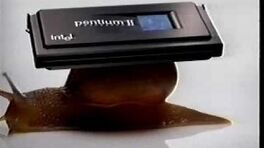- This article mainly covers the "beige" models. For more about the "blue & white" version, see Power Macintosh G3 (Blue and White).
The Power Macintosh G3 was a series of Macintosh computers from Apple that were based on the PowerPC G3 (PPC750) processor.
A major leap forward was made in this model through the introduction of a large level 2 backside cache which reduced data bottlenecks and allowed very efficient use by the computer of its bus speed. Because of this, at the time Power Mac G3 machines were widely considered to be faster than Intel PCs of similar CPU speed. The Power Mac G3 was originally intended to be a midrange series, between the low-end Performa/LC models and the high-end Power Macintosh 9600. During development, it quickly became evident that the G3 was a much faster machine than the PowerPC 604-based Macs, so the Power Mac G3 became the flagship instead.
Beige models
The original "platinum" Power Macintosh G3 series (commonly called "beige" G3s) came in three versions: a desktop enclosure inherited directly from the Power Macintosh 7500, a minitower based on a smaller version of the Power Macintosh 8600 enclosure, and a new all-in-one design that was nicknamed the "molar".[1] Equipped with 233, 266, 300, or 333 MHz PowerPC G3 CPUs from Motorola, these machines used a 66MHz bus and industry-standard PC66 SDRAM, and were one of the first Power Macs to use IDE hard disk drives. These machines had no audio circuitry on the logic board. Instead, a slot for a "personality card" was populated with an audio card on regular versions, while AV versions included a card that added S-Video capture and output. DVD-ROM drives were now an available option, and Zip drives continued to be available as well. These machines had onboard SCSI, ADB, 10Base-T Ethernet, two serial ports, and onboard ATI graphics (originally Rage II, later updated to Rage Pro) with slots for VRAM upgrade. 3 PCI slots and one internal modem slot rounded out the features.
Issues
Some early platinum G3s do not support slave devices on their IDE controllers, limiting them to one device per bus (normally one optical drive and one hard disk). This problem was tracked to Revision A logic boards and does not happen in Mac OS X.
Commercials
Blue and white models
- Main article: Power Macintosh G3 (Blue and White)
A redesigned Power Mac G3 series was introduced in early 1999 with a new translucent enclosure referred to as "blue & white". The first new Power Macintosh model after the release of the iMac, its novel case design positioned the logic board on the access door, which allowed easy access when swung down (this case style was also used on all Power Mac G4 models except for the Cube).
References
- ↑ Power Macintosh G3 All-in-one, Apple Computer. Archived 1998-04-29.
External links
- Power Macintosh G3 Series at Apple Computer (archived 1998-04-29)
- Apple Power Macintosh G3 specs at EveryMac
- Power Macintosh G3 Series at ForeverMac (archived 2011-10-06)
- Beige Power Mac G3 (1997) at Low End Mac (1997-11-15)
- Beige Power Mac G3 (1998) (1998-03-17)
- Beige Power Mac G3 All-in-One (1998-04-03)
- Image of beige minitower G3 at アフリカン王子の宮殿 Apple Macintosh & Audio & MIDI (Japanese, archived 2005-12-07)
- Power Macintosh G3 at Wikipedia
Articles
- コジマ、G3 Macintoshのグラフィック用セット (Japanese) at PC Watch (1998-02-16)
- Apple's New Macintosh G3 Range Tested in Practice by Stephan Ehrmann at Heise Online (1999-03, archived 1999-10-09)


